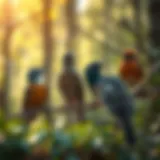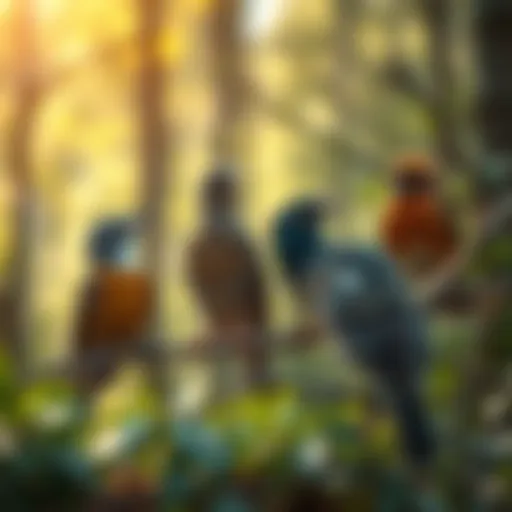Dwarf Dogwood Trees: Varieties and Care Guide


Intro
Dwarf dogwood trees are a small wonder in the world of forestry and horticulture, often overlooked yet holding significant ecological and aesthetic value. These compact trees can fit snugly into various landscapes, adding layers of beauty and diversity that are essential for vibrant ecosystems. One can't simply ignore their role in enhancing garden areas, borders, and even urban environments. This article will take a meticulous look at the characteristics, care, and cultivation of dwarf dogwood varieties, providing both novice and seasoned gardeners insights to thrive in their gardening endeavors.
As we explore these trees, we'll piece together their important characteristics - ranging from growth habit to seasonal changes - along with practical guidance on their proper care and management. Highlights will also include methods of propagation and understanding the specific diseases that commonly affect these trees. By grasping these various factors, readers can ensure their dwarf dogwood receives the love it truly deserves, growing into a stunning feature of any landscape.
Understanding Woodland Ecosystems
Woodland ecosystems are vibrant networks consisting of trees, plants, wildlife, and microorganisms. They are truly a tapestry of life, where each element plays a pivotal role. The dwarf dogwood, while modest in size, contributes immensely to this biodiverse environment.
Importance of Biodiversity in Forests
Biodiversity refers to the variety and variability of life forms within an environment. In forests, this diversity is critical for ecological stability. Dwarf dogwoods support various pollinators and other wildlife. Their flowers attract bees and butterflies, which are essential for pollination. Moreover, their berries provide food for birds and small mammals.
Role of Forests in Climate Regulation
Forests are nature’s lungs. They absorb carbon dioxide and release oxygen, playing a fundamental part in climate regulation. The dwarf dogwood’s role, though it may seem minimal, should not be underestimated. Their cover helps moderate temperatures, while their deep roots prevent soil erosion - a small tree making a big impact.
Sustainable Forestry Practices
Sustainability is key when it comes to protecting our forests. Practicing sustainable forestry ensures that natural resources are used responsibly, benefiting both the environment and society. Understanding how dwarf dogwood trees fit into these practices can offer useful insights.
Principles of Sustainable Forestry
Sustainable forestry pertains to managing forests in a way that preserves the natural ecosystem while facilitating usage. Here are a few principles:
- Maintaining biodiversity by planting a mixture of trees, including dwarf dogwoods.
- Minimizing environmental impact during harvesting activities.
- Engaging in careful monitoring of forest health and regeneration, ensuring that future generations enjoy similar benefits.
Case Studies of Successful Implementations
Numerous organizations have adopted sustainable practices that include dwarf dogwoods. For example, some community projects in the northeastern U.S. showcase these trees in combination with other local species to restore degraded areas. The results have been impressive, with biodiversity flourishing as old systems are revitalized.
Woodland Stewardship Techniques
Stewardship emphasizes responsible management of forests, recognizing that humans have a duty to care for these precious resources. Specific techniques focus on long-term health and productivity of woodland ecosystems.
Forest Management Plans
Creating an effective forest management plan is fundamental for any woodland area. These plans often encompass:
- Tree planting strategies, including selecting dwarf dogwood varieties that adapt well to their setting.
- Regular monitoring of tree health, ensuring that they remain free from diseases and pests.
- Long-term considerations for climate adaptation, adjusting practices as conditions change.
Conservation Strategies
Incorporating conservation into forest management fosters resilience. Strategies may include:
- Conserving genetic diversity by recognizing the importance of different dwarf dogwood variants.
- Implementing controlled burn practices to manage underbrush and promote healthier forest structures.
Through diligent management and stewardship, dwarf dogwoods and their larger woodland companions can thrive, ensuring the survival of diverse ecosystems. As we delve deeper into the discussion, the next sections will concentrate on the myriad of dwarf dogwood varieties, exploring their unique traits and care requirements in detail.
Overview of Dwarf Dogwood Trees
Understanding dwarf dogwood trees is essential for anyone interested in horticulture or landscape design. These trees play an integral role in our ecosystems, serving not only as stunning ornamental plants but also as important contributors to biodiversity. Their unique size makes them particularly well-suited for both residential and urban landscapes, where space can be at a premium. In this article, we will explore the various characteristics, care needs, and cultivation practices associated with these lesser-known but significant trees.
Defining Dwarf Dogwood Trees
Dwarf dogwoods, belonging primarily to the genus Cornus, are characterized by their smaller stature compared to their larger cousins such as the flowering dogwood. Typically, these trees do not exceed 15 feet in height, making them ideal selections for compact gardens and smaller spaces. The leaves range from ovate to elliptic, often displaying rich green hues that can turn brilliant shades in the fall. Additionally, dwarf dogwoods exhibit stunning blooms in late spring or early summer. Many varieties produce clusters of small, white, pink, or red flowers that can attract pollinators, providing a multi-faceted appeal.
Ecological Roles and Benefits
Dwarf dogwood trees fulfill important ecological roles. Their thick canopies provide necessary shade and create microhabitats for various wildlife species. The berries produced by dogwoods are a food source for birds and other small mammals, contributing to local diets and ecosystem dynamics. Moreover, these trees help stabilize the soil, reducing erosion through their root systems. In essence, planting dwarf dogwoods is not merely an aesthetic choice; it's a way to make an ecological statement, reinforcing the bonds between our gardens and the broader natural world.
"Dwarf dogwood trees, with their ability to adapt to various environments, are nature's versatile players in urban forestry."
Aesthetic Contributions in Landscaping
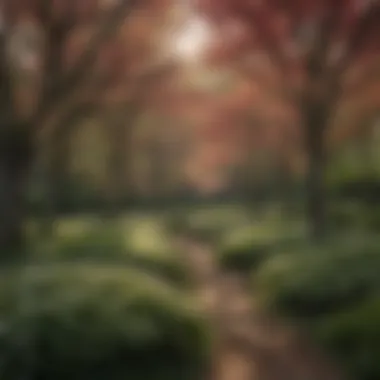

From a landscaping perspective, dwarf dogwoods bring a unique charm that stands out in various designs. Their seasonal transformations provide year-round interest: delicate flowers in spring, lush foliage in summer, rich autumn colors, and even appealing winter silhouettes. The wide range of available varieties allows gardeners and designers to choose specific traits, such as varied flower colors or different growth habits, to perfectly fit their landscape vision. Furthermore, dwarf dogwoods can be used effectively in mixed borders or as focal points in smaller gardens, enhancing the overall beauty and diversity of any space. Sensitive to their surroundings, these trees can elevate the aesthetic experience of gardens, encouraging more mindful interactions with nature.
Classification of Dwarf Dogwood Varieties
Understanding the classification of dwarf dogwood varieties is fundamental to appreciating their roles in landscapes and ecosystems. It helps gardeners, foresters, and environmentalists make informed decisions about which varieties to plant based on their specific needs and the characteristics of their environments. Furthermore, recognizing differences between native and cultivated species can aid in selecting plants that are well-adapted to local climates and soil conditions, enhancing ecological balance.
In this section, we delve into the distinctions between native and cultivated varieties, and we explore a few popular types of dwarf dogwoods, like Pagoda, Redosier, and Gray dogwoods. This classification allows us to highlight their unique contributions and challenges, leading to a more successful cultivation experience.
Native Versus Cultivated Varieties
Native dogwood species, as the name implies, are those that grow naturally in specific regions without human intervention. They play vital roles in local ecosystems, providing food and habitat for various wildlife. Native varieties tend to be resilient and well-adapted, often exhibiting a stronger disease resistance and an inherent ability to thrive in local soil and climate conditions.
On the other hand, cultivated varieties are selectively bred for desirable traits such as size, color, or even flowering patterns. While these varieties can offer remarkable aesthetics or ornamental benefits, they might not always support local biodiversity to the extent that native options do.
Choosing between native and cultivated should consider the goals of the planting, whether those be for habitat restoration, aesthetic landscaping, or functional uses in gardens.
Popular Varieties Overview
Pagoda Dogwood
The Pagoda Dogwood (Cornus alternifolia) stands out with its unique layered, tiered branching structure, resembling a pagoda—hence the name. This feature not only offers a striking visual but also provides shelter for various birds and small mammals, nurturing a healthy ecosystem. Its white flower clusters, followed by blue-black berries, add to its appeal, making it a favored choice for homeowners seeking to add beauty and diversity to their gardens. However, care must be taken since Pagoda dogwood can be susceptible to certain diseases, particularly anthracnose. With proper management, this tree's advantages greatly outweigh the disadvantages, securing its spot in many landscapes.
Redosier Dogwood
Redosier Dogwood (Cornus sericea) is known for its striking red stems, providing a vibrant contrast in the winter garden landscape. This characteristic alone makes it a popular choice for gardeners looking to maintain visual interest year-round. It thrives in moist areas and is often used for stabilizing banks, making it functional and beautiful. Moreover, its creamy white blossoms in spring attract pollinators, and the berries are a food source for birds. A disadvantage, however, is its aggressive spreading nature if not managed, which could overshadow other plants in the vicinity. Despite this, its contributions to winter aesthetics and wildlife support make it a valuable addition.
Gray Dogwood
The Gray Dogwood (Cornus racemosa) presents another compelling option with its dense foliage and distinctive gray stems. This variety is particularly adaptable to various soil types and can tolerate wetter conditions. Its multifaceted ecosystem benefits include providing cover and forage for numerous bird species while aiding in the prevention of soil erosion. While this tree can also spread prolifically, which may require appropriate management, its robust nature and wildlife benefits make it a worthy candidate for both natural habitats and cultivated landscapes.
In summary, understanding the classification and features of dwarf dogwood varieties facilitates informed choices for planting, ultimately enhancing both aesthetics and ecological integrity in various settings.
Growth Characteristics
Understanding the growth characteristics of dwarf dogwood trees is crucial for anyone looking to incorporate these plants into their gardens or landscapes. These traits go beyond mere aesthetics and influence how these trees will fit into specific environments. By knowing the height and spread, leaf variations, and flowering patterns, gardeners can make informed decisions. This knowledge supports not only the health and vitality of the trees but also the overall harmony of the landscape.
Height and Spread Measurements
Dwarf dogwood trees typically range in height from around two to ten feet, depending on the specific variety and growing conditions. For example, the Pagoda dogwood usually stands at a modest height, making it an excellent choice for smaller spaces. It's noteworthy to measure both height and spread as these trees can often take up significant room. Their spread can vary considerably, sometimes reaching up to twelve feet in width. This characteristic is especially important when planning the layout of a garden or yard to avoid overcrowding.
Households should consider these measurements when selecting the right dwarf dogwood for their landscape. The interplay of height and spread allows for a layered effect in shrub borders, which is visually appealing. Furthermore, understanding these dimensions impacts maintenance practices, ensuring that pruning opportunities are well-timed and executed.
Leaf Characteristics and Variations
The leaves of dwarf dogwoods come in a variety of shapes and colors, providing a significant aesthetic contribution. Most commonly, the foliage ranges from dark green to variegated forms. For instance, the Gray dogwood boasts broad, lush green leaves that can turn vibrant shades in autumn, creating a stunning array.
Leaf variations can differ not only between species but also from one cultivar to another. Leaves may exhibit different textures from smooth to somewhat serrated edges. These differences not only enrich visual appeal but also influence ecological aspects. For example, certain leaf types may attract different pollinators or resist pest damage more effectively.
It's important to note that leaves can be indicators of the tree's health. Yellowing or browning can signal nutrient deficiencies or water stress, underscoring the interconnected nature of growth characteristics and care.
Flowering and Fruiting Patterns
The flowering and fruiting habits of dwarf dogwoods are intriguing components of their growth characteristics. Some dwarf varieties offer delicate blooms in spring, which can range in color from pristine white to soft pink. These flowers attract a variety of pollinators, adding to the ecological importance of the trees.
Many dwarf dogwoods produce berries in late summer or early fall. Not only do the berries provide sustenance for birds and other wildlife, but they also contribute to the visual appeal of the tree as they develop in vibrant hues. The presence of fruit can add seasonal interest to gardens, shifting the focus throughout the year.
A noteworthy observation is that some varieties have a more prolific fruiting habit than others. This can affect choices in cultivation depending on whether a homeowner wishes to maximize the ecosystem benefits or highlights certain ornamental aspects.
By recognizing their unique growth characteristics, growers can enhance the appeal of their landscapes while supporting local biodiversity.
Cultivation Practices
Understanding the cultivation practices for dwarf dogwood trees is essential for those wishing to achieve a flourishing and vibrant garden. Cultivation encompasses the methods and techniques that ensure the healthy growth of these trees, which in turn influences their appearance and ecological contributions. As the saying goes, "you reap what you sow," and it rings especially true in horticulture. Each aspect—from soil preparation to watering practices—plays a pivotal role in the vitality of dwarf dogwoods.
Soil Requirements and Preparation
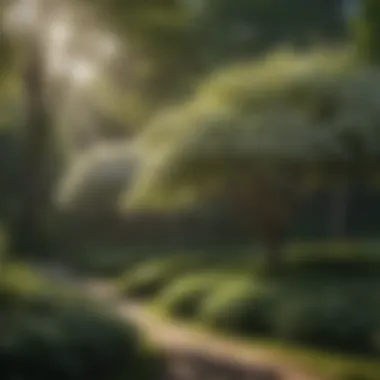

When it comes to soil, it is vital to remember that dwarf dogwood trees thrive best in well-drained, loamy soils that are rich in organic matter. The texture of the soil helps determine how well moisture and nutrients are retained. Generally, a pH level ranging from 5.5 to 7.0 tends to support optimal growth.
To prepare the soil, you should till the area to break up any compaction and mix in a generous amount of compost or aged manure. This enriches the soil structure, enhancing its fertility and drainage capabilities. As one gardener wisely said, "A good foundation makes all the difference!" Monitor moisture levels as you prepare, ensuring the soil remains damp but not soggy—but make sure not to overwater, as this can lead to root rot, which can be fatal for these young trees.
Light and Watering Needs
Dwarf dogwoods are relatively adaptable but do prefer spaces with a mix of sunlight and shade—think about dappled sunlight filtering through leaves. Ideally, they need about four to six hours of sunlight daily. Planting them too close to larger trees can restrict their light intake, stunting their growth. It's a bit like trying to run in a crowded hallway—it just doesn’t work well.
When it comes to watering, consistent moisture is key. Although dwarf dogwoods can tolerate periods of drought, it's best to give them a good soaking once or twice a week, particularly in the first couple of years after planting. Keep an eye on the soil—if it feels dry a couple of inches down, it’s time to water. However, avoid waterlogging the soil; these trees do not enjoy their roots swimming around in muddy conditions.
Fertilization and Nutrient Management
Nurturing your dwarf dogwood requires a thoughtful approach to fertilization. These trees can benefit from a balanced fertilizer during the growing season, ideally in late winter or early spring before new growth begins. Using a product with equal parts nitrogen, phosphorus, and potassium (often indicated by a 10-10-10 ratio) promotes healthy foliage and flowering.
In addition, organic matter can serve as a slow-release fertilizer. As the organic matter breaks down in the soil, it provides nutrients on a more gradual basis, which can be less shocking to the plants compared to high doses of synthetic fertilizers.
To summarize,
- Keep your soil loamy and well-drained, with a healthy pH.
- Position your trees for optimal light exposure.
- Implement a consistent watering schedule to prevent drought stress.
- Consider balanced fertilization for optimal growth.
By attending to these cultivation elements, anyone can support the biodiverse nature and exquisite beauty that dwarf dogwood trees can bring to their landscapes and gardens.
Pest and Disease Management
Managing pests and diseases in dwarf dogwood trees is crucial for ensuring their health and longevity. These trees, while resilient, are not immune to various biological threats. Addressing these threats not only protects the individual trees but also enhances the overall landscape’s ecological integrity. Pests and diseases can impact growth, flower production, and even the tree's ability to thrive in its environment.
Understanding how to identify and treat these issues can save both time and resources, making it a significant part of cultivation. Whether you are a seasoned horticulturist or a beginner gardener, grasping the importance of pest and disease management can dramatically improve your gardening experience and outcomes.
Common Pests Affecting Dwarf Dogwoods
Dwarf dogwoods may encounter several common pests, which can sap their vitality. Some of the frequent offenders include:
- Dogwood Borer: The larvae of this pest bore into the wood, creating galleries that disrupt the flow of nutrients and water. Signs include wilting leaves and dieback.
- Scale Insects: Small and often unnoticed, these pests attach themselves to the bark. They can cause yellowing leaves and stunted growth by sucking the sap.
- Spider Mites: These arachnids thrive in dry conditions. Their webbing can be spotted on the underside of leaves, often resulting in browning and leaf drop.
- Aphids: Known for their rapid reproduction, aphids can crowd leaves and stems, leaving behind a sticky residue known as honeydew, which attracts sooty mold.
To combat these pests, it’s vital to monitor your trees regularly. Early detection can significantly simplify treatment options and minimize damage.
Diseases and Their Treatment Options
Dwarf dogwoods are susceptible to various diseases that are equally concerning. Key ailments include:
- Powdery Mildew: This fungal disease creates a white powdery coating on leaves. While it rarely kills the tree, it can weaken it over time. To treat powdery mildew, consider using fungicides or improving air circulation around the tree.
- Dogwood Anthracnose: A serious fungal disease that can cause significant leaf damage and branch dieback. Management may include the removal of infected branches and applying fungicidal treatments during the early growing season.
- Septoria Leaf Spot: Characterized by dark spots on leaves, it can lead to premature leaf drop. Avoid overhead watering and ensure good drainage to lessen the severity.
When faced with a disease, it’s essential to assess the extent of the impact and implement treatment options promptly to prevent further spread.
Preventive Measures for Healthy Growth
Preventing pests and diseases is always preferable to treating them. Here are some effective strategies:
- Regular Inspections: Schedule routine checks on your trees, particularly during growing seasons when pests are active.
- Proper Watering Practices: Water early in the day to allow foliage to dry by evening, reducing fungal disease risks.
- Soil Quality: Healthy soil fosters robust plants. Ensure the soil has good drainage and is rich in organic matter.
- Diversity in Planting: Instead of planting a single species, include a variety of plants in your landscape. This biodiversity can deter pests and lessen the impact of diseases.
- Pruning: Regularly prune to maintain air circulation and direct sunlight. Remove any dead or diseased branches to minimize infection risks.
Effective pest and disease management is essential to cultivate resilient dwarf dogwoods that contribute positively to any landscape.
By incorporating these practices, gardeners can achieve a thriving environment for dwarf dogwoods, allowing these charming trees to flourish beautifully.
Propagation Techniques
Propagation techniques are central to the cultivation of dwarf dogwood trees, as they provide various methods to expand and enhance these unique species in both home gardens and broader landscapes. Understanding the nuances of propagation not only helps in preserving specific varieties but also contributes to genetic diversity within a population. From an ecological perspective, ensuring the survival of these trees is highly relevant given their roles in local ecosystems—such as providing shelter and food for wildlife. Furthermore, mastering propagation techniques allows gardeners and landscaping professionals to multiply their plants effectively, ensuring abundant and healthy growth. In this section, we will delve into two primary methods of propagation: seed propagation and vegetative methods such as cuttings and grafting.
Seed Propagation Methods
Seed propagation stands out as one of the most natural ways to reproduce dwarf dogwood trees. This method is straightforward but does require patience, as seeds often have specific requirements for stratification and germination. When planting dwarf dogwood seeds, timing is crucial. Ideally, seeds should be sown in the fall. This approach mimics natural cycles, allowing seeds to undergo winter stratification, which can be critical for their germination.
Here are a few key pointers for successful seed propagation:
- Seed Collection: Gather seeds after they have matured in the late summer or early fall. The ripe seeds should be strong and plump; avoid any that appear shriveled or discolored.
- Stratification Process: After collecting, seeds may need to be stratified. This process can involve soaking seeds for a day, followed by mixing them with damp sand and storing them in a cold environment for several weeks.
- Planting: After stratification, seeds can be sown directly into the ground or planted in pots. They should be lightly covered with soil, as dwarf dogwood seeds need some light to germinate effectively.
- Watering and Care: Keep the soil consistently moist, but not soggy, during the early stages of seed growth. As they sprout, regular monitoring for pests and potential disease is essential, helping the new plants grow robustly.
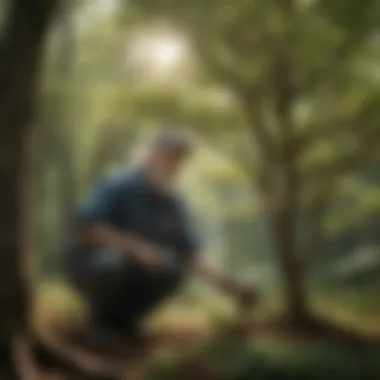

Each seed germination can be unpredictable—some may sprout the following spring, while others might take longer, depending on individual conditions.
Cuttings and Grafting Techniques
Cuttings and grafting present alternative methods to propagate dwarf dogwoods, both of which can offer faster and more reliable results than seed propagation. These techniques are particularly useful when cloning specific cultivars or enhancing the genetic traits of certain varieties. The success of both methods hinges on careful execution and proper timing.
Cuttings
Taking cuttings involves trimming sections of a healthy plant and encouraging them to grow roots. Softwood cuttings are ideal for dwarf dogwoods, typically taken in late spring or early summer.
- Selecting Cuttings: Choose healthy, non-flowering stems that are about 4 to 6 inches long. These should be cut just below a leaf node for optimal rooting.
- Preparation: Remove the leaves from the lower half of the cutting, as excess foliage can lead to moisture loss. A rooting hormone can be applied to the cut end to stimulate root development.
- Planting: Insert the cuttings into a pot filled with moistened potting mix, keeping them in a warm, humid environment until roots develop. Regular misting can help maintain humidity.
Grafting
Grafting is a more advanced propagation technique that involves joining parts of two plants together so they grow as one.
- Choosing Scion and Rootstock: Select healthy scionwood from the desired variety of dwarf dogwood and compatible rootstock. The aim is to combine the best characteristics of both plants.
- Grafting Process: There are various methods, such as whip-and-tongue or cleft grafting. Both need precision and care to ensure the cambium layers of both plants touch, facilitating successful union.
- Post-Grafting Care: After grafting, secure the union with grafting tape and provide appropriate conditions until the graft takes hold. This may involve special watering and shading techniques.
"Grafting is like jazz—timing and harmony create beautiful music between two plants."
By utilizing seed propagation, cuttings, and grafting, cultivators can effectively increase their dwarf dogwood tree population, tapping into the unique characteristics and benefits that these trees bring to any landscape. This level of understanding is critical for both horticulture enthusiasts and professionals alike, who aim to nurture and expand their botanical collections.
Landscaping with Dwarf Dogwoods
When it comes to creating a visually appealing landscape, dwarf dogwoods offer a plethora of opportunities that can elevate the aesthetic of any outdoor space. Their unique structures and seasonal changes ensure they play a significant role in garden design, not just as individual plants but as integral components of a well-planned landscape. It's all about understanding their versatility and how they can complement various design themes.
Integrating into Shrub Borders
Dwarf dogwoods can serve as fantastic specimens within shrub borders. Their relatively compact growth allows them to fit seamlessly alongside other bushes, providing a layered effect that gives depth to the landscape. When selecting a variety for your shrub border, consider the color of the foliage as well as the hues of the flowers. For instance, the Pagoda Dogwood produces striking horizontal branching with white blooms, making it a standout piece amidst darker shrubs.
When positioning these trees, it’s wise to consider their mature size and growth habits. Placing them towards the back ensures that taller plants provide the necessary backdrop without overshadowing the dwarf varieties. Furthermore, incorporating evergreens in front of or beside the dogwoods can help maintain some structure and greenery during the winter months when deciduous trees are bare.
"A well-placed dwarf dogwood can transform a simple border into a vibrant tapestry of colors and textures."
Designing Native Plant Gardens
Native plant gardens are gaining traction among landscapers and homeowners alike. Dwarf dogwoods fit naturally into this scheme since many varieties are native to various regions. They not only support local ecosystems but also attract pollinators like bees and butterflies. Opting for plants that coexist in the wild creates a harmonious feel, promoting biodiversity.
When planning your native plant garden, think about contrasting textures. Pairing a Redosier Dogwood with softer plants can create a dynamic look. This particular dogwood, with its brilliant red stems in winter, pairs beautifully with delicate ferns or wildflowers that bloom in spring and summer.
While crafting this natural unity, attention to seasonal changes is paramount. Choosing a variety with excellent fall color, such as certain types of Gray Dogwood, can extend visual interest long after the summer blooms have faded.
Utilizing in Smaller Spaces
In urban environments or smaller residential lots, the space available for landscaping can present a challenge. Dwarf dogwoods are superb choices for tight spots, providing texture and color without overwhelming the area. Their manageable size allows them to thrive in confines where larger trees would struggle.
When working with limited space, consider utilizing dwarf dogwoods as focal points. Planting them in planters or as standalone specimens can draw the eye, making a statement without overcrowding. Look for a compact variety, such as the Cornus sericea, which does not exceed several feet in height and can create an attractive visual centerpiece even from a distance.
Additionally, dwarf dogwoods are useful in mixed plant beds. They can be the linchpin around which other plants are spaced, allowing for creative layering with annuals, perennials, or ornamental grasses. This not only maximizes color and texture but also ensures that even smaller spaces can reflect a rich diversity of life.
In sum, dwarf dogwoods are increasingly cherished in landscaping. Their adaptability and charm make them a go-to candidate for myriad designs. By thoughtfully integrating these trees, one can achieve a dynamic, engaging landscape that reflects both personal style and ecological integrity.
Culmination
Concluding an exploration of dwarf dogwood trees unveils several crucial insights not only about their diverse varieties but also about their ecological and aesthetic significance in modern landscaping practices. This section wraps up the key themes discussed throughout the article, highlighting their practical application for forestry professionals and academics alike. The significance of dwarf dogwoods stretches beyond mere ornamental use; they play vital roles in soil stabilization, provide habitat for wildlife, and contribute to the overall biodiversity of their environments.
Summary of Key Points
The discussion has shed light on several fundamental aspects regarding dwarf dogwoods:
- Diversity: The variety within dwarf dogwood trees, including native and cultivated species, showcases their adaptability to different landscape conditions.
- Care Practices: Emphasizing appropriate soil conditions, light requirements, and pest management is crucial for optimal growth and health.
- Propagation Techniques: Understanding methods such as seed propagation and grafting expands options for enthusiasts looking to cultivate these trees.
- Landscaping Potential: Integrating these trees into shrub borders or small gardens illustrates their versatility and aesthetic appeal.
This summary encapsulates the essence of cultivating dwarf dogwoods, reiterating their suitability for a range of gardening styles while supporting ecological health.
Future Directions in Dwarf Dogwood Research and Cultivation
Looking ahead, the realm of dwarf dogwood research seems promising. With a growing emphasis on ecological landscaping and sustainable gardening, more in-depth studies are likely to be conducted on the genetics and resilience of these trees. Future research may focus on:
- Enhancing Resistance to Pests and Diseases: There's a profound need to explore genetic variations among dogwood trees that confer resistance to common threats.
- Ecological Roles in Urban Settings: As urban areas expand, understanding how dwarf dogwoods can mitigate urban heat and contribute to air quality will become increasingly pertinent.
- Hybrid Varieties Development: Cross-breeding may lead to varieties that are better suited for specific climates or offer enhanced decorative traits.
The exploration of these future avenues will not only enrich our understanding of dwarf dogwoods but also support their integration into sustainable practices in both urban and rural settings. This commitment to research and refinement alerts specialists to ongoing opportunities that could shape the future of dwarf dogwood cultivation.






